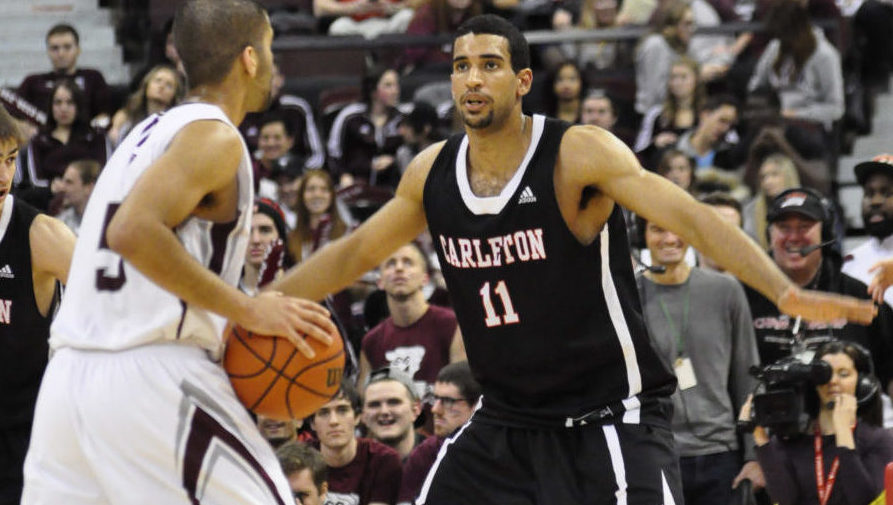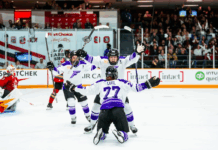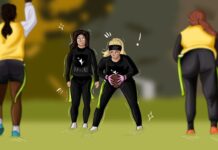When the Carleton Ravens and University of Ottawa (U of O) Gee-Gees hit the court on Feb. 3 as part of the Capital Hoops Classic, it will mark ten years since the inaugural event.
The first Capital Hoops was held on Jan. 23, 2007, when U of O guard Josh Gibson-Bascombe hit a game-winning buzzer beater to win it for the Gee-Gees by a score of 64-62 in front of 9,750 fans at the Canadian Tire Centre (CTC), then known as Scotiabank Place.
Only a men’s basketball game was played as part of the first Capital Hoops Classic, though the women’s basketball game was added to the event the following year.
Since the inaugural event, the rivalry has been considered the best U SPORTS basketball rivalry in the nation, and the teams will meet for the 11th Capital Hoops Classic this year.
“We needed a big sports stage [between Carleton and U of O] in the post-Panda Game era,” said former director of communications for Carleton Doug Wotherspoon, referring to the period when Carleton did not have a football team.
Drew Love, former athletic director at Carleton and one of the architects of the Capital Hoops Classic, said the idea for the game began from discussions on how they could promote basketball in the Ottawa Valley, as well as build their case for hosting the Canadian Interuniversity Sport (CIS—now U SPORTS) National Championships.
At that point in time, Halifax had been the sole home for the basketball National Championships for nearly 25 years. The Capital Hoops Classic provided an opportunity to prove Ottawa as a suitable host for the prestigious event, according to current Carleton athletic director Jennifer Brenning.
Brenning said she still remembers how she felt in 2007 at the inaugural event.
“I was absolutely thrilled. How loud it was, seeing Carleton students in red and [U of O] in white, the whole atmosphere was amazing,” Brenning said.
According to Brenning, the entire infrastructure was new and they learned a lot in that first year, especially in the preparation.
The first choice for the game’s location was Lansdowne Park, but they could not get the city to engage with Carleton organizers. They did not have the hardwood for the basketball court and were heavily involved with Skate Canada in providing the facility. From there, the university reached out to the Ottawa Senators, according to Brenning.
“The support of the Senators was crucial,” Love said. “They provided everything we needed and were really set on making [the CTC] multi-sport.”
Based in part on the success of that first game, the City of Ottawa won the bid for the men’s basketball National Championships for three consecutive years from 2008-2010 and has hosted Toronto Raptors training camps.
“When you have a lot of success, you start considering crazy ideas as possible. That type of spirit and enthusiasm allowed us to dream big,” Wotherspoon said, and added that winning four consecutive National Titles at the time helped build the profile for the event.
“Pushing clubs such as Red Zone and C Red really helped market the Ravens and increase their popularity. They were incredibly helpful in making Capital Hoops happen,” Wotherspoon said.
Ali Norton, one of the founding members of Red Zone, said they wanted to provide a way to help students discover the basketball programs which, despite their success, had struggled to fill Alumni Hall on game nights.
“I hope it’s been a really positive thing—something that has brought students, staff, faculty, parents, alumni, and the broader community together,” Norton said.
Love said outside of big events like the Capital Hoops Classic, there is typically limited coverage of university sport in Canada besides student-led publications such as The Charlatan.
“The game itself has generated an excitement and a life of its own . . . these events draw the attention of people who aren’t avid fans and show them the quality of the programs that we have here,” Love said.
The first Capital Hoops Classic came in the midst of Carleton’s fifth consecutive national title run, beginning a dynasty that is still in full force to this day.
“It is always a playoff-type atmosphere that the players look forward to being a part of,” said Osvaldo Jeanty, a five-time CIS champion guard for the Carleton Ravens from 2002-07.
Jeanty, an Ottawa native, played in the first Capital Hoops Classic during his last year playing for the Ravens, but has followed the event every year since.
“Every year it gets bigger and bigger. It means so much for Carleton and [U of O]. It means so much for the city,” Jeanty said.
Carleton has only lost two of the 10 Capital Hoops Classic men’s basketball games—the first one in 2007 and last year’s 78-72 loss to the Gee-Gees on Feb. 5, 2016. The Ravens recovered from the defeat to their crosstown rivals to end last season with their sixth consecutive national championship.
Wotherspoon said he recognizes the importance of the Capital Hoops Classic in increasing the profile of basketball at Carleton, but says the effect of the event and the Ravens men’s basketball dynasty goes beyond just the one sport.
“Would football have been brought back without the basketball team’s success? Would Alumni Hall and the Ice House have been built? I am not so sure,” Wotherspoon said.
Ten years after the inception of the Capital Hoops Classic, the Ravens and Gee-Gees will meet on Feb. 3 at Canadian Tire Centre, writing the next chapter in their historic rivalry.
– File Photo






